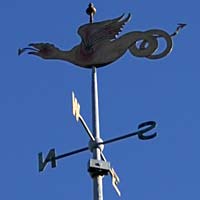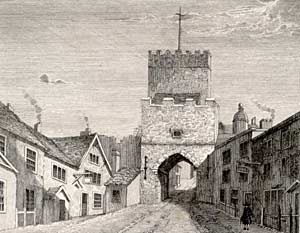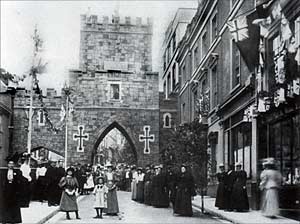
The North Gate
Page updated 13th October 2010
 The
North Gate of the city was not on the same scale as the great East and
South Gates, but it was the entrance for goods and travellers from
North Devon. The gate had two guard-rooms with orillons for the
defenders to fire their arrows when the gate was under attack. The
interior was used as a public house which was named Hell due to its darkness. It was
demolished in June 1769.
The
North Gate of the city was not on the same scale as the great East and
South Gates, but it was the entrance for goods and travellers from
North Devon. The gate had two guard-rooms with orillons for the
defenders to fire their arrows when the gate was under attack. The
interior was used as a public house which was named Hell due to its darkness. It was
demolished in June 1769.
The North Gate was the scene of several attempts to seize the city. In 1497, Perkin Warbeck, an imposter who claimed he was the youngest son of Edward IV and therefore the rightful heir, landed in Cornwall, from Cork, Ireland. He recruited an army of supporters and ten days later, appeared at the North Gate of the city in his attempt to usurp the throne from Henry VII. Warbeck burnt the North Gate, but the citizens fed the flames with extra fuel and dug a ditch behind, making entry into the city impossible. He eventually managed to storm the city through the East Gate, but fled to Taunton when he heard that Edward Courtenay, the Earl of Devon was approaching.
There were several important coaching inns that terminated services below the North Gate, because the roadway was too steep for horse drawn vehicles to enter the city through the gate. The Barnstaple Inn was probably the most prominent, although the Falcon Inn stood "near the site of the ancient Northgate." There was a cold bath by the gate, supplied by a spring that flowed ".. from under the City walls", which was re-discovered in 1880, during an excavation of buildings in the area. Alexander Jenkins wrote rather enigmatically that the bath was "... much frequented by the female Jews."
In the mid eighteenth century, when Methodism was spreading, the Methodists second meeting place in the city was in a room over the North Gate, presumably right above Hell.
Wet feet
One citizen of Exeter wrote to the Flying Post and recounted that before the Ironbridge was constructed, the Longbrook flowed at the bottom of Lower North Street, beneath the North Gate, and how in wet weather it overflowed. The writer quoted an old citizen from his childhood who said "old people like myself, who knew Exeter in the early part of this century, can better understand than the late generation the reasons for the partiality for 'pattens' which existed amongst the ladies of that day. With the Improvement Commissioners, and the flagging and paving of the city, the patten and clog declined." A 'patten' was a sort of over cover for a shoe.
The Jubilee
At the city end of the Iron Bridge is a stone which was placed there in 1897 for Queen Victoria's Diamond Jubilee, on which is inscribed:
Attached to the stone is a tall pole with a weather vane in the shape of a Wyvern or gilded dragon with a long, curly tail. The Wyvern was the original weather vane that was over the North Gate before it was demolished in June 1769 and moved to the roof of the Wharfinger's Office, on the Quay. A report in the Flying Post of 9th June 1769 stated "We are desired to insert the following: On Wednesday last, very early in the morning, the workmen employed to take down the North Gate of the city of Exeter found on the top of the house over the gate a flying serpent, which they have taken. And we hear that the same has been presented to the Right Worshipful the Mayor of the said city."
For the celebration a public subscription raised more than £40 to build a wooden arch across the road, that was a copy of the old gate. The committee requested permission to move the weather vane from the quay and erect it temporarily over the arch.The architect for the decorative arch was Mr Jerman, and by the 10th June, Messrs Woodman and Son and Mitchell and Son started the building, decorating and painting the arch. Arrangements were made to illuminate it with electric light and decorate North Street, St David's Hill and the Ironbridge. The arch was in place for about three weeks for the celebration, for by 7th July it was reported that it had been taken down. Two photographs were taken of the arch, by Mr Davey – one on Jubilee Day (see photo right) and one while the arch was dismantled.
After the Jubilee, the committee announced a surplus of £10 10s 9d. It was decided to raise some more funds to place a stone memorial and plaque with the iron column on top, by the road side, and the Wyvern weather vane was placed in position.
In 1975, the Civic Society paid for the weather vane be restored and placed back on the top of the pole. It supposedly has dents in it, from bullets fired during the English Civil War - Exeter was a Royalist stronghold for much of this period and the city sustained a long siege from the Parliamentarians.
The Wyvern was taken down for restoration in the 2000s, and carefully investigated by the Royal Albert Memorial Museum. X-ray analysis by Flybe at Exeter Airport revealed that it is constructed of two copper sheets that are fixed together with a tube running vertically through the middle for it to be fixed on the pole – the X-ray revealed a hidden, lead counterweight between the sheets. Further inspection revealed that it had been painted yellow, probably in 1897, before a brass finish was applied by the Civic Society in 1975.
The Wyvern is to be displayed at RAMM, while the museum had a replica made by Neil Bolling that was paid for by the Civic Society and placed back on the pole at the North Gate during May 2010
Source: Flying Post, Devon and Cornwall Notes and Queries, Alexander Jenkins, and Nonconformity in Exeter 1650-1875 by Allan Brockett.

The North Gate from outside the city. Courtesy Devon Library Services.
 The
Diamond Jubilee North Gate, 1897. Click to enlarge.
The
Diamond Jubilee North Gate, 1897. Click to enlarge.
│ Top of Page │